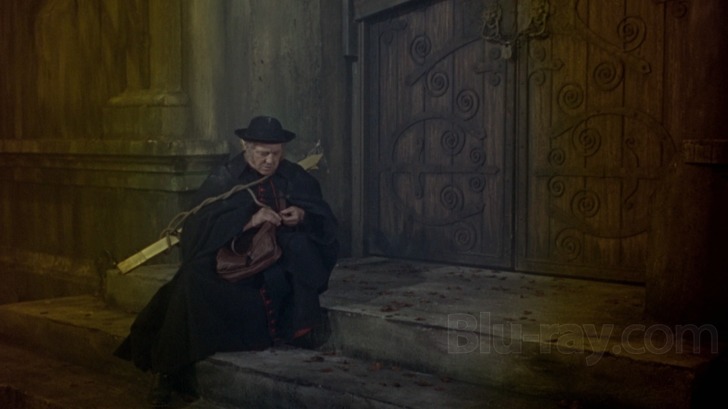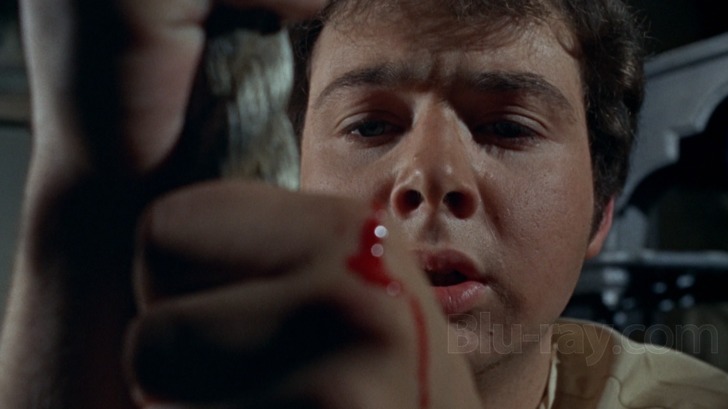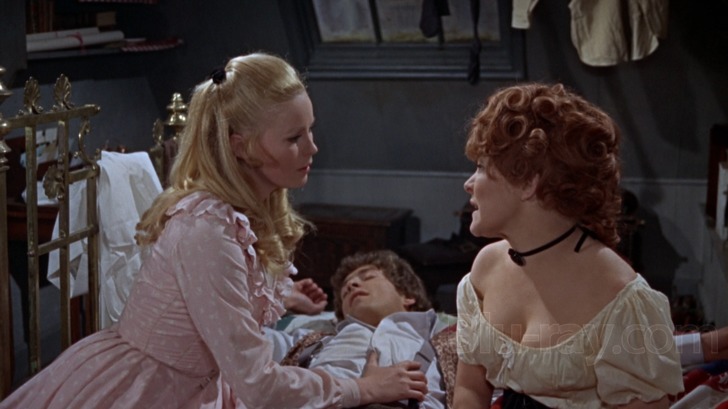Dracula Has Risen from the Grave Blu-ray Movie
HomeDracula Has Risen from the Grave Blu-ray Movie 
Warner Bros. | 1968 | 92 min | Rated G | Oct 06, 2015Movie rating
6.8 | / 10 |
Blu-ray rating
| Users | 4.0 | |
| Reviewer | 3.0 | |
| Overall | 3.0 |
Overview
Dracula Has Risen from the Grave (1968)
When his castle is exorcised, Dracula plots his revenge against the Monsignor who performed the rites by attempting to make the holy man's young niece his bride.
Starring: Christopher Lee, Rupert Davies, Veronica Carlson, Barbara Ewing, Barry AndrewsDirector: Freddie Francis
| Horror | Uncertain |
| Drama | Uncertain |
| Fantasy | Uncertain |
| Romance | Uncertain |
Specifications
Video
Video codec: MPEG-4 AVC
Video resolution: 1080p
Aspect ratio: 1.78:1
Original aspect ratio: 1.85:1
Audio
English: DTS-HD Master Audio Mono (48kHz, 24-bit)
French: Dolby Digital Mono
German: Dolby Digital Mono
Spanish: Dolby Digital Mono
Spanish: Dolby Digital Mono (Spain)
Subtitles
English SDH, French, German SDH, Japanese, Spanish
Discs
25GB Blu-ray Disc
Single disc (1 BD)
Playback
Region A, B (C untested)
Review
Rating summary
| Movie | 2.5 | |
| Video | 4.0 | |
| Audio | 3.0 | |
| Extras | 0.5 | |
| Overall | 3.0 |
Dracula Has Risen from the Grave Blu-ray Movie Review
. . . And You May Catch Glimpses of Him in This Sequel
Reviewed by Michael Reuben October 6, 2015Warner Home Video's first volume of Hammer Horror Films contains two of the sequels to the famed British studio's successful 1958 reboot of the Dracula franchise, both starring the late Christopher Lee in a role that, until Lee played it, was so thoroughly identified with Bela Lugosi that most actors would have been afraid to tackle it. The success of the 1958 film, due in no small part to Lee's commanding performance, helped confirm Hammer's status as a major player in the international market, and eight sequels followed. Lee did not appear in Brides of Dracula (1960), but he returned for Dracula: Prince of Darkness (1966), which introduced the character of Father Sandor, played by Andrew Keir, who assumed the mantle of Peter Cushing's Van Helsing as Dracula's chief nemesis. At the conclusion of Prince of Darkness, Dracula was entombed in the icy waters near his castle outside the German town of Karlsbad. Which brings us to 1968 and Dracula Has Risen from the Grave (or "DHRftG"). There's nothing wrong with this sequel that a little more of Dracula wouldn't cure, but considering the film's production issues, its stylistic flourishes are the best it can offer. Director Terence Fisher, who had helmed the three previous films, became unavailable after sustaining injuries in a car accident. Into his place stepped cinematographer (and occasional director) Freddie Francis, whose visual gifts can be seen in such diverse projects as Dune and Martin Scorsese's Cape Fear. Francis' eye provided flair to an uninspired script by Anthony Hinds (writing under the name John Elder) that underutilizes both the character of Dracula and the gifts of the actor playing him.

In a prologue meant to show Dracula's earlier reign of terror, an altar boy (Norman Bacon) finds the bloody corpse of a young woman when he goes to ring the evening church bells. The stylishly grisly discovery is one of the film's best scenes, as the terrified boy is struck dumb by the discovery. His priest (Ewan Hooper) prays for divine salvation. A year later, Dracula has been defeated by Father Sandor (whose name isn't mentioned), but the priest, the boy and the town have never recovered. On a routine inspection of the parish, Monsignor Ernst Muller (Rupert Davies) finds a town of broken souls who still feel the shadow of Dracula's castle hanging over them. Monsignor Ernst, who is this film's Van Helsing, resolves to "exorcise" the castle and seal it with a cross, but he needs the priest to guide him through the mountains. The Monsignor's quest is successful, but the exhausted priest cannot complete the journey and accidentally (or is it really an accident?) releases Dracula (Lee) from his watery tomb. Finding his castle barred by a cross, Dracula vows revenge on the Monsignor and presses the terrified priest into service as the latest version of Renfield. For a long time, however, Dracula is little more than a supporting player in the film, as Monsignor Ernst returns home, and DHRftG becomes a domestic soap opera about his niece, Maria (Veronica Carlson), and her would-be fiancé, a baker's apprentice named Paul (Barry Andrews). Paul is an atheist, which scandalizes Monsignor Ernst, although his sister-in-law, Anna (Marion Mathie), would clearly like to see her daughter happily wed. Bar maid Zena (Barbara Ewing), who works at the tavern where Paul bakes, isn't disappointed that the engagement is off, since she has a large appetite and a roving eye, which makes her a suitable hors d'oeuvres for the vampire shortly to arrive. (For those keeping score at home, Paul = Jonathan Harker; Maria = Mina; and Zena = Lucy.) One of the standard devices for maintaining a monster's presence, even when he's not onscreen, is to have the characters talk about him in fearful tones, but DHRftG largely dispenses with even that simple trick, because it takes so long for the fanged Count to make his presence known. He's so thoroughly sidelined in the film's long middle section that it's Maria, not Dracula, who prowls the nighttime, demonstrating formidable acrobatic skills as she navigates the city's rooftops from her bedroom window to Paul's. (Once she arrives, though, they only talk.) Meanwhile, Zena is stalked and eventually killed; the Monsignor finally discovers that his priest has become Dracula's creature; and Maria is abducted by Dracula, who carries her back to his castle, which he hopes to reopen. Paul follows, and the final battle leads to the vampire's gory demise. Lee is as commanding as always, and Carlson makes a winsome damsel in distress. Director Francis and his cinematographer, Hammer stalwart Arthur Grant, use bold colors and strong shadows to create visual interest. At least there's always something worth looking at.
Dracula Has Risen from the Grave Blu-ray Movie, Video Quality 

For its Blu-ray debut, Dracula Has Risen from the Grave has been newly scanned at 2k by Warner's MPI facility from a recently made IP. The results on this 1080p, AVC-encoded Blu-ray are so impressive that one can enjoy the full theatrical artificiality for which Hammer Films is so justly famous. The blood of Dracula's victims has a thickness and color unknown in nature; the wounds on their necks look like stage makeup; and the various sets resemble scenes from a play (which they might as well be). It's the stylized photography, with filters around the frame in key shots, that transforms these stage-bound conventions into cinema. This Blu-ray presentation conveys the cinematic quality more effectively than any prior version. Detail, depth, black levels and color density are all superior. A fine grain pattern is observable throughout. The only shots that are inferior are the stock establishing shots of several villages, and those are not the fault of the transfer. In yet a further sign that a new regime is settling in at Warner Home Video, DHRftG has been mastered with an average bitrate of 29.94 Mbps, which far exceeds the historical WHV approach. The compression has been skillfully performed.
Dracula Has Risen from the Grave Blu-ray Movie, Audio Quality 

DHRftG's original mono track is encoded in lossless DTS-HD MA 1.0 and sounds just fine within the limits of its source material. Dialogue is always clear, as are the sound effects, even when they don't quite match the action. (Is the cross that Monsignor Ernst uses to seal Dracula's castle made of wood or metal? The sound effects suggest metal, but other indications say wood.) Some of the dialogue is unsynchronized, but this is due to post-dubbing and (probably) script changes. The melodramatic score by Hammer regular James Bernard sounds somewhat tinny and shrill, but again this appears to be a source issue.
Dracula Has Risen from the Grave Blu-ray Movie, Special Features and Extras 

Other than a trailer (480i; 1.78:1, enhanced; 2:29), the disc has no extras. Warner's 2004 DVD was similarly featureless.
Dracula Has Risen from the Grave Blu-ray Movie, Overall Score and Recommendation 

Such was the reputation of Christopher Lee and Hammer Films in 1968 that DHRftG was both successful and highly profitable, but over time it has suffered in comparison to the other films in Hammer's Dracula series. For volume 2 of Warner's Hammer collection, here's hoping we get the 1958 Horror of Dracula, which began the franchise. DHRftG isn't the place to start, but for fans of the series, Warner's presentation is recommended.
Similar titles
Similar titles you might also like

Taste the Blood of Dracula
1970

Frankenstein Must Be Destroyed
1969

Dracula A.D. 1972
1972

Horror of Dracula
Dracula / Warner Archive Collection
1958

Dracula: Prince of Darkness
Collector's Edition
1966

The Mummy
1959

Scars of Dracula
1970

The Satanic Rites of Dracula
Count Dracula and His Vampire Bride
1973

Son of Dracula 4K
1943

Dracula
Collector's Edition with Theatrical & Badham color
1979

The Brides of Dracula
Collector's Edition
1960

Dracula
Includes "Drácula"
1931

Dracula's Daughter 4K
1936

Drácula 4K
1931

The Haunted Palace
1963

Black Sunday 4K
The Mask of Satan / La maschera del demonio 4K
1960

Blood & Chocolate
2007

Kiss of the Damned
2012

Twins of Evil
1971

The Vampire Lovers
Collector's Edition
1970

